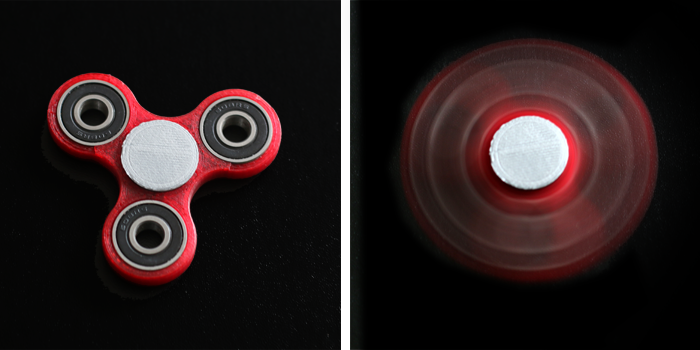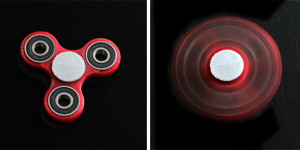Science with Fidget Spinners
Fidget spinners are incredibly popular right now with kids. There is some argument about whether or not there is "science" behind the claims that the toy helps some kids focus, and some schools have gone so far as to ban the toys. At Science Buddies, we are more interested in the fun science kids can DO with these toys. From 3D printing and design to data analysis and even physics, with fidget spinners on hand, kids can tap into engaging science explorations this summer and turn the "spin" into a learning experience.

The Fidget Spinner Craze
Over the last few months, fidget spinners have gained widespread popularity with elementary and middle school kids. A small handheld toy, fidget spinners come in a wide range of models, differentiated first by the number of blades (or prongs) and then by the type of bearing, the color, and the material. One of the most well-known styles is the popular three-blade fidget spinner, with ball bearings in each prong and in the center. Made from plastic and skateboard ball bearings, fidget spinners do just one thing—they spin.
Whether they actually reduce fidgeting, help alleviate stress, or improve concentration or focus has been hotly debated by the media. Despite the claims that the sensory experience of spinning a fidget spinner may be calming or focusing for some students, some schools have banned the toy. Beyond the media hubbub about the toy, most kids playing with fidget spinners probably don't care whether the spinner has psychological grounding or not. Fidget spinners are simply cool and fun to handle. (And maybe when they spin a fidget spinner, they thump their desk less, or shift around in their seat less, or bite their nails less, or twirl their hair less, or tune in better to the lesson being taught and have better recall later. Maybe.)
What is it about a fidget spinner that makes it so fascinating for kids? Why have kids latched on to these little bits of spinning plastic? Maybe it is the action of flicking a fidget spinner to keep it spinning. (It takes a bit of practice. You might even get a bit of a blister or a callous before you find your fidget spinner flow, and perfecting that flow for the smoothest spin is part of the challenge.) Maybe it is the sound the spinner makes while it spins. (Some spinners are quieter than others, but some spinners do make a whirring noise as they spin.) Maybe it is the sensation of the spinner spinning, the simple feel of it in the hand. Or maybe it is the movement of air created by the spinning, a small fidget-spinner-induced breeze. Ask a fidget spinner fan, and you might get one of many different answers about the appeal of the toy, but for a true spinner fan, the toy is always close at hand.
If you have never tried a fidget spinner, maybe you should! Before you move on to find ways to explore science with a spinner, try a spinner just to see what the craze is all about. Pick the spinner up. Hold the center bearing between your thumb and finger, top and bottom, and use a finger from your other hand to give one of the blades a firm push to set the spinner in motion. How long does it spin? Is the spin smooth? Do the blades bump into your hand? What does the "spin" feel like? What does it sound like? If you have another spinner on hand, spin it. Does it behave the same? If there are differences, what are they and why?
Today, there are independent online sellers, mainstream sellers, and scads of videos showing fidget spinners in action. That the toy is totally analog, doesn't plug in or light up or involve a screen, makes the fidget spinner an unexpected novelty, almost anachronistic, on the kid scene. But hot schoolyard toys are often similarly and surprisingly analog. Last year, the must-have toy in some areas was the Kendama, a wooden ball attached by a string to a handle with a wooden spoke on which you try and catch the ball. In prior years, Beyblades (which also spin) were popular, and before that, there were Bakugan. Shaped ("silly") rubber bands had their turn at school, as did rubber band bracelets. And, in the mix, proving its longevity, yo-yos come and go in the hive mentality of the schoolyard. Periodically, a student comes along with some serious sleeper or walk the dog yo-yo skills, and the classic "spinning" toy gains renewed interest.
Despite the fact that all they do is spin, as this school year winds down, fidget spinners have taken the top spot on the playground. Fidget spinners are cool, but beyond spinning, what can you do with a fidget spinner? Science, of course!
Data at Hand
Sellers of custom fidget spinners often sell spinners made from different materials or with different kinds of ball bearings. To help fidget spinner fans decide what kind of custom spinner they want, many sellers provide extensive information about the differences in spin time with different kinds of bearings. Better (longer-spinning) bearings typically mean higher prices, but for fidget spinner connoisseurs, getting the longest and smoothest spin possible is often the goal. (The length of spin is one of the few ways that fidget spinner owners can "compare" their spinners with others, which often plays into schoolyard interest.) While longer-spinning bearings have appeal, they may also make more noise, so sorting out the pros and cons of various options becomes important for prospective buyers.
Students with access to an assortment of fidget spinners can turn this "keep your hands occupied" toy into a quantitative, data-gathering science project by testing and comparing spinners with different kinds of bearings or with different numbers of spokes. Do different bearings really make a difference in how long a spinner spins? Different bearings also may make differing amounts of noise. Does a spinner with 2 blades spin as long as a three-pronged spinner? It is easy to do some testing, gather data, and draw conclusions! Students can explore data charting and graphing, find averages, experiment with histograms, and more!
Students with access to an Android phone can also experiment with using Google's Science Journal App to record and compare the noise of different spinners. For more information about using the Science Journal app, see: Google's Science Journal App Transforms a Cell Phone into a Powerful Tool for Science Class
Colorful Spin
Watching a spinner can be mesmerizing. Depending on the colors and patterning of the spinner, you may see illusions during the spinning, including illusions related to color. Some spinners are striped or have more than one color. What happens when the spinner spins? Depending on the colors on the spinner and the spacing of the bands of color, your eyes may see a different color completely or what looks like concentric rings of color. What kinds of patterns can you create by experimenting with the arrangement of color on the top of the spinner?
With a spinner on hand, students can adapt the Spinning Colors: How Do Primary Colors Combine to Make New Colors? project to learn more about color and light. The project typically uses a drill with a sanding disk to create a spinning surface. The objective of the project is to investigate how primary colors combine to make new colors.
With a fidget spinner, students can create their own "disks" out of cardstock (or other lightweight paper) to cover the blades of the spinner with different colors (or patterns). When they spin the fidget spinner, what will they see?
3D Printing
Students interested in printing their own spinners can experiment with 3D modeling and design to create their own 3D printing file for a spinner body. With a custom body printed out, kids can buy their own skateboard bearings and pop them in place for a totally DIY fidget spinner experience. The Design and 3D-Print Your Own Robot! * project at Science Buddies is about designing robots, but interested students can use this information as a launching point for experimenting with the 3D design of fidget spinners.
Making Connections
Kids you get excited about the science they can explore with a fidget spinner may also enjoy projects and STEM investigations like these:
- How Long Will My Sleepy Yo-yo Sleep?
- There's a Machine in My Toy Box!
- The 'Ultimate' Science Fair Project: Frisbee Aerodynamics
- Physics Secrets for Hula Hooping
- Make Monkeys Fly in the Blink of an Eye
- Skipping Science: An Experiment in Jump Rope Lengths
- Rubber Bands for Energy
- Slinking Slinkies
- Whirly Bird Aerodynamics
- Spinning Your Wheels: Pinwheel Sensitivity
- Take a Candle Carousel for a Spin
- Other projects that can use the Google Science Journal Ap
Additional Reading
For other media and science coverage of fidget spinners, see:
- Let's Explore the Physics of Rotational Motion With a Fidget Spinner
- Want to Know How Long a Fidget Spinner Spins? Get a Laser and Some Physics
- Here's The Science Behind The Fidget Spinner Craze
- Fidget Toys Aren't Just Hype
- Fidget Spinners: What They Are, How They Work and Why the Controversy
Categories:
You Might Also Enjoy These Related Posts:
- Star Wars Projects for May the 4th Be With You Science
- Mario Day STEM — Bring Mario World to Life with Hands-on Science and Engineering Activities!
- When Your Science Project Opens a Wormhole--Alternate Universe Movie for Science Class
- Science with Fidget Spinners
- Water on Mars—From Sci-Fi to Space Science
- A Dolphin Tail and Prosthetics Engineering
- LEGO Movie Makes Engineering Awesome
- Iron Man and Fiber Optics—Technology at the Speed of Light










